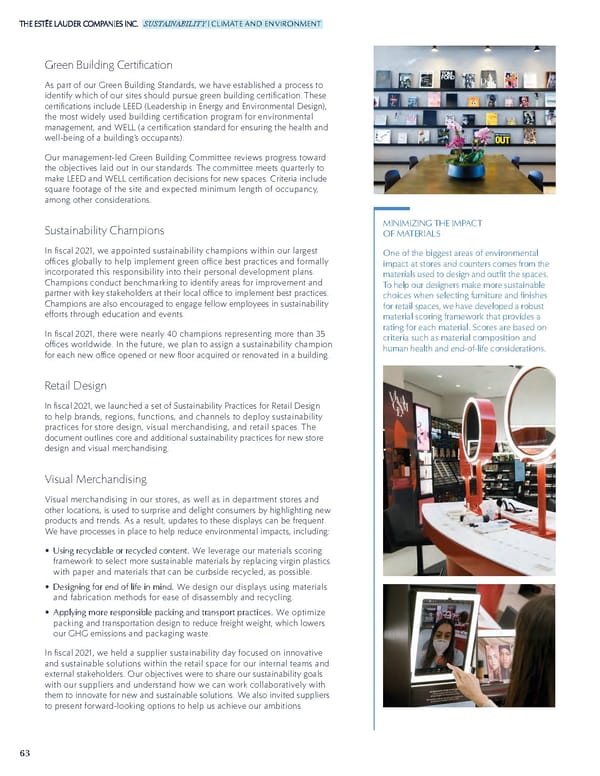63 SUSTAINABILITY CLIMATE AND ENVIRONMENT MINIMIZING THE IMPACT OF MATERIALS One of the biggest areas of environmental impact at stores and counters comes from the materials used to design and outfit the spaces. To help our designers make more sustainable choices when selecting furniture and finishes for retail spaces, we have developed a robust material scoring framework that provides a rating for each material. Scores are based on criteria such as material composition and human health and end-of-life considerations. Green Building Certification As part of our Green Building Standards, we have established a process to identify which of our sites should pursue green building certification. These certifications include LEED (Leadership in Energy and Environmental Design), the most widely used building certification program for environmental management, and WELL (a certification standard for ensuring the health and well-being of a building’s occupants). Our management-led Green Building Committee reviews progress toward the objectives laid out in our standards. The committee meets quarterly to make LEED and WELL certification decisions for new spaces. Criteria include square footage of the site and expected minimum length of occupancy, among other considerations. Sustainability Champions In fiscal 2021, we appointed sustainability champions within our largest offices globally to help implement green office best practices and formally incorporated this responsibility into their personal development plans. Champions conduct benchmarking to identify areas for improvement and partner with key stakeholders at their local office to implement best practices. Champions are also encouraged to engage fellow employees in sustainability efforts through education and events. In fiscal 2021, there were nearly 40 champions representing more than 35 offices worldwide. In the future, we plan to assign a sustainability champion for each new office opened or new floor acquired or renovated in a building. Retail Design In fiscal 2021, we launched a set of Sustainability Practices for Retail Design to help brands, regions, functions, and channels to deploy sustainability practices for store design, visual merchandising, and retail spaces. The document outlines core and additional sustainability practices for new store design and visual merchandising. Visual Merchandising Visual merchandising in our stores, as well as in department stores and other locations, is used to surprise and delight consumers by highlighting new products and trends. As a result, updates to these displays can be frequent. We have processes in place to help reduce environmental impacts, including: • Using recyclable or recycled content. We leverage our materials scoring framework to select more sustainable materials by replacing virgin plastics with paper and materials that can be curbside recycled, as possible. • Designing for end of life in mind. We design our displays using materials and fabrication methods for ease of disassembly and recycling. • Applying more responsible packing and transport practices. We optimize packing and transportation design to reduce freight weight, which lowers our GHG emissions and packaging waste. In fiscal 2021, we held a supplier sustainability day focused on innovative and sustainable solutions within the retail space for our internal teams and external stakeholders. Our objectives were to share our sustainability goals with our suppliers and understand how we can work collaboratively with them to innovate for new and sustainable solutions. We also invited suppliers to present forward-looking options to help us achieve our ambitions.
 Estee Lauder Companies Sustainability Report Page 63 Page 65
Estee Lauder Companies Sustainability Report Page 63 Page 65